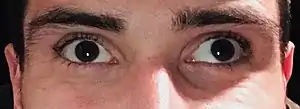Strabismus
Strabismus is a condition in which the eyes do not line up with each other when looking at an object.[2]
| Strabismus | |
|---|---|
| Other names | Heterotropia, crossed eyes, squint[1] |
 | |
| A person with exotropia, an outward deviated eye | |
| Pronunciation |
|
| Medical specialty | Ophthalmology |
| Symptoms | Nonaligned eyes[2] |
| Complications | Amblyopia, double vision[3] |
| Types | Esotropia (eyes crossed); exotropia (eyes diverge); hypertropia (eyes vertically misaligned)[3] |
| Causes | Muscle dysfunction, farsightedness, problems in the brain, trauma, infections[3] |
| Risk factors | Premature birth, cerebral palsy, family history[3] |
| Diagnostic method | Observing light reflected from the pupil[3] |
| Differential diagnosis | Cranial nerve disease[3] |
| Treatment | Glasses, surgery[3] |
| Frequency | ~2% (children)[3] |
References
- "Strabismus noun - Definition, pictures, pronunciation and usage notes | Oxford Advanced Learner's Dictionary". www.oxfordlearnersdictionaries.com. Archived from the original on August 1, 2017. Retrieved August 1, 2017.
- "Visual Processing: Strabismus". National Eye Institute. National Institutes of Health. June 16, 2010. Archived from the original on October 5, 2016. Retrieved October 2, 2016.
- Gunton KB, Wasserman BN, DeBenedictis C (September 2015). "Strabismus". Primary Care. 42 (3): 393–407. doi:10.1016/j.pop.2015.05.006. PMID 26319345.
This article is issued from Wikipedia. The text is licensed under Creative Commons - Attribution - Sharealike. Additional terms may apply for the media files.